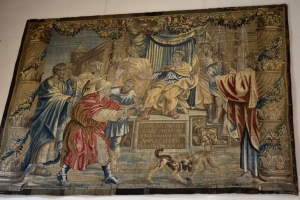Originally known as The Baron’s Hall, the two-storey high Great Hall is an amazing recreation of an Elizabethan Great Hall with features such as the baronial raised dais for the high table at one end and cross passage at the other, the oriel window, and the stone screen. Only three such screens survive in England, the others being located in Wollaton and Hardwick Halls.
The Hall design is definitely the work of Salvin, derived from the Jacobean Hall at Audley End, Essex. Salvin had worked on the restoration of the medieval hall at Brancepeth Castle, County Durham, for Matthew Russell. Russell was the brother-in-law of Charles Tennyson d’Eyncourt, who advised his relative in the restoration. Tennyson d’Eyncourt consulted Salvin when he had his own house built, Bayons Manor, Lincolnshire, in 1836. This would have been at the same time that Salvin was working on Harlaxton Manor. Tennyson d’Eyncourt was the executor of Gregory Gregory’s will.
The marble floor is embedded with the crosses from the Gregory coat of arms, which can be seen carved in stone over the fireplace.
The oriel window overlooking the garden reputedly has the world’s largest pendant.
The oak projections in the panelling are like bosses from 16th century Italian shields.
The carved decoration of screens and overmantle is like much of the exterior decoration, and was derived from Wendel Dietterlin’s Architectura, 1598.
Stone arches at the far end support the minstrel gallery, which once housed a small organ.
The roof style is Elizabethan, with centre bosses of plaster.
The Renaissance Atlantes are similar to those on the Cedar Staircase and are reminiscent of those seen in Italian fountain sculptures such as ones in the Borghese Gardens in Rome. The Atlantes, bearing the world, are driven to despair by the burden they carry.
Mrs. Van der Elst purchased the Belgian crystal chandelier around 1940 at a good price after it failed to get to a palace in Madrid at the start of the Spanish Civil War. The chandelier is of Marie Therese shape, made of flat bed crystal drops. It is most likely to have arrived flat-packed with the branches being made up of segments pinned together and the electric cable running along the top of the branch. The chandelier was last cleaned in 2014. There is reference to the Hall being lit in earlier times by a massive brass chandelier with 60 lights and two Venetian lanterns (The Grantham Journal, 1859)
The tapestry is early 18th century Flemish, depicting the Acts of the Apostles. It is attributed to Philippe and Michel Wauters, after Raphael, and shows the blinding of Elymas the sorcerer. It is a copy of the Raphael Cartoons originally commissioned by Pope Leo X for a set of ten tapestries to complete the decoration of the Sistine Chapel. These designs were later copied in Antwerp for the English market.
In 1859 the most noticeable articles in the Hall were: ” a beautiful Chinese gong and screen; a lofty oak side-board, the panels and principal carvings of which were brought from the Continent and arranged in their present form by the admirable taste of the late proprietor. It contains superb vases and punch bowls, and lower down a large oak carving of two mermaids painted white bearing a conch with dolphins, looking upwards. Old portraits adorn the walls, “Duke of Buckingham,” “Earl of Colchester,” “Earl of Burlington,” “Philip II, of Spain and his page,” “Mary Queen of Scots,” “Henry VIII,” “George de Ligne Gregory,” “Charles I,” by Webb, all splendidly painted and in fine preservation. Other articles of virtue are two Chinese screens, two buhl caskets, elaborately bound with brass work; portfolio containing drawings and sketches by the late Mr. Gregory.” In the stained glass window recess were “two antique pier glasses in ebony frames and an ebony chair, from the late Duke of York’s collection; there are also five antique chairs formerly belonging to Dukes of Saxony, they bear the following inscriptions: “John Georgius,” “Georgious IV,” “Albertus,” “Augustus,” and “Heuricus.” An exquisite marble bust by W. Theed, Esq., artiste of the “Newton Statue,” is a conspicuous object of this portion of the Hall; it bears the inscription “Gregory Williams Gregory, who caused this mansion to be erected 1830-1854.”
From Reminiscences of a visit to Harlaxton Manor House, The Grantham Journal, Saturday May 28, 1859.










